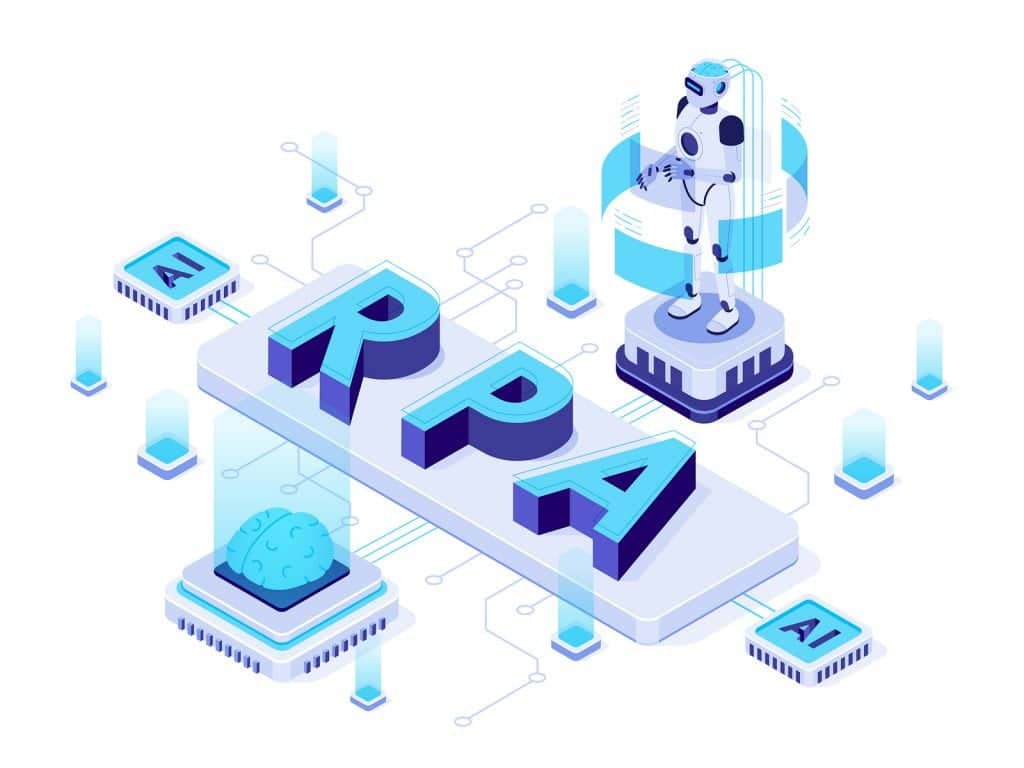Welcome to the third installment of our robotic process automation (RPA) series. In Part 1 we learned what robotic process automation is, discussed its benefits, and provided some real-world examples of what can be achieved with RPA. For Part 2 we focused on the employment opportunities RPA is creating, how widespread adoption of RPA tools will impact the job market, and what training and certification resources are available to those looking to pursue a career in RPA. In this third part, we take a look at Gartner’s recently released Magic Quadrant for Robotic Process Automation Software and consider the top five RPA tools highlighted in the paper.
Table of Contents
ToggleThe Robotic Process Automation Market
As a market, robotic process automation is still relatively small. Gartner valued it at less than $850 million in 2018 – however, rapid growth is expected in the coming years. In fact, RPA is the fastest-growing software subsegment officially tracked by the research firm. Gartner expects robotic process automation software revenue to reach $1.3 billion in 2019. Figures from Grand View Research suggest the market will hit $3.97 billion by 2025, registering an impressive CAGR of 31.1%!
“The RPA market has grown since our last forecast, driven by digital business demands as organizations look for ‘straight-through’ processing,” said Research Vice President at Gartner, Fabrizio Biscotti. In 2018, the top five RPA vendors controlled 47% of the market. However, as shown in the table below, the vendors ranked sixth and seventh – Kofax and NTT-AT – achieved triple-digit revenue growth.

(Image source: gartner.com)
Gartner notes that while robotic process automation software can be found in all industries, currently the biggest adopters of the technology are banks, insurance companies, telcos, and utility companies. These organizations traditionally have many legacy systems, says Gartner, and choose RPA solutions to ensure integration functionality. “The ability to integrate legacy systems is the key driver for RPA projects,” Biscotti adds. “By using RPA technology, organizations can quickly accelerate their digital transformation initiatives, while unlocking the value associated with past technology investments.”
So, let’s take a look at Gartner’s RPA Magic Quadrant.

(Image source: gartner.com)
In all, 18 RPA vendors were analyzed on their effectiveness in responding to the demands of modern business. Below, we take a closer look at the top five (as per Table 1 above), and consider the robotic processes automation tools they offer and how they can be utilized in your business.
Top 5 Robotic Process Automation Tools
- UiPath

At the top of the Leaders quadrant is UiPath. Thousands of enterprises and government agencies use UiPath’s Enterprise RPA Platform to rapidly deploy software robots that emulate and execute repetitive processes across back- and front-office operations – boosting productivity while ensuring compliance and enhancing the customer experience.
The platform can be deployed either in the cloud or on-premises and consists of three integrated components:
- UiPath Studio –The process modeling environment where users can (with minimal training and no coding) model robotic process automations visually using powerful recorders that build automation by watching the user work. Also included is a rich template library that provides users with customizable templates for common processes.
- UiPath Robot –The UiPath Robot opens, acts upon, and closes any local, legacy, or cloud application and extracts, processes, and passes data between any structured and semi-structured data source (applications, documents or databases). It is driven by advanced computer vision to perform rapid and precise automation for SAP, Citrix and Mainframe processes.
- UiPath Orchestrator – This is the management console that licenses, configures, and deploys UiPath Robots. It assigns automations and work queues to the bots and then schedules their activities.
Gartner cites the intuitive user experience as a core strength of UiPath’s robotic process automation solution, as well as its strong security, resilience, and integration options. Example uses for the technology include document management, data extraction and migration, application integration, and various supply chain, human resources, and finance and accounting operations. UiPath provides an example of the solution at work in invoice extraction and processing in the video below.
(Video source: youtube.com)
- Automation Anywhere

Automation Anywhere bills itself as a platform that is powerful enough to automate tasks of any complexity, yet user-friendly enough for anyone to use. The software automates rules-based tasks through software robots that can automate practically any back-office process end-to-end and run independently with minimal human intervention.
As one of the most popular robotic process automation solutions, Automation Anywhere sits inside the Leaders quadrant and is used to automate business processes in a wide variety of industries and organizations. Examples of where Automation Anywhere is being used include:
- Finance/Accounting – Invoice processing, reporting, auditing
- HR – Automating tasks such as employee time tracking, email notifications, populating employee data
- Operations/IT – Creating accounts, software set-up, batch processing, system integrations, etc.
- Sales – Creating and printing invoices; adding, modifying and removing customer data in CRM
- Marketing – Creating lead generation reports and monitoring social sentiment
- Government – Verification processes, populating subcontractor forms, automating daily reports, etc.
- Healthcare – Patient data migration, reporting for doctors, insurance data automaton and claim processing, claim status, patient record storage, etc.
A key strength that Gartner cites is pre-integrated components that allow Automation Anywhere to provide extensions to its product with effective functionality accessible from within the platform itself. For example, customers can link through to IBM’s business process management tooling, or they can leverage their relationship with Celonis for process mining.
An overview of the latest Automation Anywhere Enterprise A2019 RPA platform is provided in the demo video below.
(Video source: youtube.com)
- Blue Prism

Blue Prism is the third and final vendor to appear in Gartner’s Leaders quadrant. Like Automation Anywhere and UiPath, Blue Prism’s robotic process automation software solution provides the capability for automating processes that would otherwise be executed manually. Designed with key attributes that make it enterprise safe, scalable, and capable of running without the need for constant monitoring, the Blue Prism solution focusses on the enterprise-wide deployment of a “Virtual Workforce” of software robots.

(Image source: blueprism.com)
Gartner highlights Blue Prism’s strong verticalization strategy with industry-focused experts, campaigns, website navigation and partners, as a key strength of the platform. This strategy has yielded 42 separate industry-specific solutions covering everything from financial services to manufacturing, hospitality, utilities, and life sciences.
A short overview of the latest release of Blue Prism’s Digital Workforce is provided in the video below.
(Video source: youtube.com)
- NICE

Positioned in the Challengers quadrant, NICE is a robotic process automation software technology provider of workforce engagement management (WEM) solutions specifically for customer service applications, case management, and employee engagement.
The key difference between NICE and the other solutions on this list is that the focus is on augmenting people, rather than automating end-to-end. This is best exemplified with NEVA (NICE Employee Virtual Attendant) – a software robot that organizations can deploy in the call center to gather all the necessary documentation needed to deal with a call, put it in the right kind of format, and provide the contact center employee with real-time assistance – such as next-best-action, and next-best offer guidance for efficiency, compliance and sales purposes.
(Video source: youtube.com)
- Pegasystems

Pegasystems appears in Gartner’s Visionaries quadrant. It offers robotic process automation as a standalone product, as well as a feature of its enterprise intelligent business process management software (iBPMS) solution.
Pega’s robotic process automation platform provides the tools organizations need to create software robots to automate tedious manual work and repetitive tasks – such as data input when onboarding customers and updating customer information in systems of record – as well as a runtime environment for those robots. After bots ,, the Pega Robot Manager is the central application used to manage them.
The Pega Robotic Desktop Automation (RDA) solution helps customer service representatives work faster and more efficiently by automating key tasks and workflows and facilitates communication between multiple desktop applications while they engage with customers.
(Video source: youtube.com)
Final Thoughts
Robotic process automation tools are gaining prominence in the enterprise. In fact, according to Deloitte’s most recent Global RPA Survey, 53% of organizations have already started implementing RPA. The number is projected to rise to 72% by 2020 – and near-universal adoption is expected within the next five years.
Organizations should consider carefully the RPA tools available. To ensure a successful implementation, it’s essential to have a clear understanding of the capabilities of each automation system and a clear vision of the processes you want to automate. If you’re currently researching robotic process automation solutions, we recommend you explore the solutions listed above as a starting point – these are the top five RPA tools on the market today. However, it’s important that you meticulously consider costs, user-friendliness, scalability, security, industry specificity, and the maintenance and support services that each vendor offers before making your final decision.
Top Automation Tools
The top Robotic process automation (RPA) tools from Gartner’s recently released Magic Quadrant for Robotic Process Automation Software report are: UiPath, Automation Anywhere, Blue Prism, Nice, Pegasystems. As a market, robotic process automation is still relatively small. Gartner valued it at less than $850 million in 2018 – however, rapid growth is expected in the coming years. In fact, RPA is the fastest-growing software subsegment officially tracked by the research firm. Gartner expects robotic process automation software revenue to reach $1.3 billion in 2019. Figures from Grand View Research suggest the market will hit $3.97 billion by 2025, registering an impressive CAGR of 31.1%!

